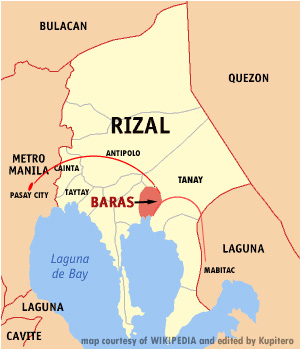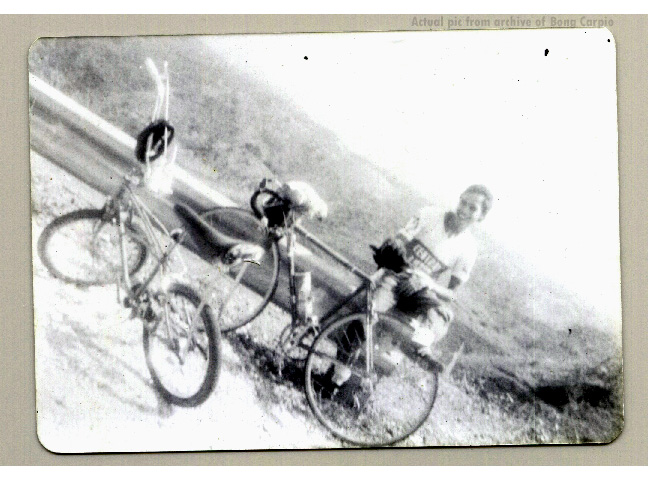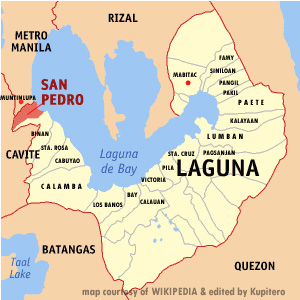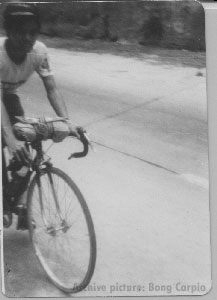The year was 1977, and Ferdinand Marcos was still the Philippine president. A few months back, Jimmy Carter was sworn in as the 39th President of the U.S., and I had just completed my freshman year in college.
It was our summer vacation and so, earlier that week, Ray and I decided that we would go biking to the hills of Antipolo, Rizal (a quiet but relatively big town, approx. 20 km northeast of Manila).
I woke up at about 4:00 AM that Sunday put on my cycling gear, and poured the de-fizzed Coke I placed in the fridge the night before into the plastic bottles attached to my bike.
After a brief inspection of my steed (tires, gears, brakes), the road map, and my camera, I rolled on — to the scent of fresh-baked ‘pan-de-sal ‘in the still-dark streets of Parañaque and headed towards Pasay City…where Ray and his family had moved.
Ray and I were childhood friends in Baclaran, where his family had lived, even by the day I began remembering things. That was until the owner of their apartment unit decided to lease out the entire complex to a Chinese businessman, forcing them to move elsewhere.
He was younger by about 6 yrs, but we shared the same interests: playing all sorts of street games, billiards, ‘dama‘ (a local version of checkers, usually played in barber shops), swimming at the Manila Bay -its water was still relatively clean, and people could still catch some fish – and, of course, biking.
I called his name through the window in his room, conveniently situated on the side of yet another apartment complex along Facundo Street. He had already prepared the night before and, in no time, we found ourselves pedaling furiously eastward to Pasig, Rizal, which is now a city and part of greater Metro-Manila.
Although not very far from Manila, Antipolo is a cyclist’s bane since most of it is situated on the eastern slopes of the Sierra Madre mountain range, which gives the city a spectacular view of Metro Manila.
But why did we go biking there? It was the month of May, and traditionally, people, especially in predominantly Catholic Philippines – from all over the country, trek to the place to pay homage to the ‘Nuestra Senora Dela Paz y Buenviaje‘ (Our Lady of Peace and Good Voyage) – a black-imaged Virgin that came from Acapulco, Mexico that was used during the Galleon Trade. Also, there are numerous spring resorts in Antipolo that offer a bit of relief during the hot summer months in the country.

It took us about two hours to reach the church, and after we said our prayers, we bought some ‘kasoy‘ (cashew nuts), also abundant in the area as with the ‘Tipolo‘ tree (breadfruit), where the place got its name from and snapped some photo souvenirs, we decided to continue our trek southward to the neighboring towns of Tanay and Baras. Both are still situated in the province of Rizal.
It was mostly downhill from Antipolo along the undulating roads toward Tanay, and so we decided to eat lunch in one of the roadside ‘carinderias‘ (eateries)- they are so ubiquitous along the main highways of the entire archipelago – not long after we reached the flatter sections of the town.
I forgot what we ate but remembered that we drank more than we ate because of the noonday heat. I also ensured that my two water bottles were full for the impending climb towards Mabitac (part of Laguna Province) via Baras and, once again, Tanay.
I almost gave up as soon as we reached the brutal climbs in Mabitac. Ray, who was riding his trusty ‘play bike,’ was egging me on to continue without realizing that my steel road bike was climbing these slopes on a maxed-out 48 tooth (front chain wheel) by 18 teeth (rear gear) combo while he was leisurely pedaling on a smaller wheel with a 32 by 20 gear ratio!
I barely made it to the top! The cool breeze and the panoramic view of the Laguna de Bay gave me the ‘second wind’ I needed to pursue the journey further south. Besides, the trip back via the same roads would have probably been torture!
The rustic sceneries and the ‘genteel feel’ I had for the small ‘barrios‘ we passed by en route to Mabitac (one of the three towns in Laguna that bordered the province of Rizal – the others being, Pakil and Santa Maria) made our pedaling easier than it seemed to be.
From their ‘verandas‘ (porches) or, in front of their hardware stores, old men and women waved at us as we wheeled by.
As if our souls had briefly met high above the clouds and then looked down with puzzlement at the chaos and confusion people were creating for themselves on earth.
We bade goodbye to the mountains as soon as we entered the municipality (or town) of Famy in Laguna. It is a small town whose western tip briefly borders Laguna de Bay. Most of the towns in Laguna straddle this great lake, a source of livelihood and many folklores.
From there, the twisting roads of Siniloan led us to the more significant, eastern part of Pangil — vernacular (in singular form) for the ‘fangs of wild boars,’ which were said to be abundant and freely roamed the place.
It rained briefly while we were gingerly traversing a downhill section towards neighboring Pakil. These towns I remembered well as the “three Ps”…the next one being Paete — very well-known for its wood carvings and the sweet and succulent fruit, ‘lanzones.’ How could I not remember the sense of awe Ray and I had felt as we whizzed by these trees with their light-yellow, oval-shaped fruits right above our city-bred heads? We were not used to seeing those trees!
Also, most houses in Paete have small, thatched huts that are usually detached from their prominent abodes, where their owners can do their carvings. Some of these huts also double as small ‘sari-sari‘ (assorted goods) stores to augment their income.
In one of these ‘sari-sari’ stores along the highway in Paete, Ray and I tasted one of the best ‘pan-de-cocos‘ (bread rolls with sweet coconut fillings) in our lifetime. It was not because they were well-baked but because we were hungry after the lung-busting climbs. We washed them with “Sarsi” (a local brand of root beer, whose aromatic flavor comes from the ‘sarsaparilla’ vine) and lots of swigs from my now slightly hot water bottles. It was about 2:30 PM, and from Ray’s house in Pasay City, we had almost been on the road for more than 9 hours!

And so, we pedaled on to the towns that caressed the southeastern portion of Laguna de Bay. These were: Kalayaan, Lumban, Pagsanjan (although not bordering Laguna de Bay, we decided to pass through this town en route to Santa Cruz because of its popularity and allure), Sta. Cruz, and Pila.
It was in Pila where, again, we stopped briefly to sample one of the roadside delicacies, ‘suman‘ (a long, sticky rice cake whose flavor is enhanced by the coconut leaves it is wrapped on). These, we dipped in plain sugar for taste and to supplant our already-drained body sugar reserves.
I also happened to have a university mate and friend that lived in town, and we briefly mulled looking for his house and paying him a surprise visit. But it was almost 5:00 PM, and although it was the peak of summer, we were running out of daylight to cover the remaining nine Laguna towns and cities — and the more than 90 km of not-so-very-easy roads back to Manila. Also, given that our frail bodies were simply running on whatever glycogen reserves they had, we backed out on the idea and pedaled onto the adjacent town of Victoria instead.
From Victoria, our pace was getting slower and slower as we trundled past the towns of Calauan, Bay, and Los Baños, where its steep hills almost zapped the lights out of us and almost gave in to the thought of sleeping the night over as soon as we hit the town proper.

We knew that we were not far from home as we stopped briefly in the town of Los Baños — very near the road that leads to the International Rice Research Institute (IRRI), situated inside the University of the Philippines at Los Baños‘ (UPLB) sprawling compound.
We were also very familiar with the towns and cities we would pass along the way. Los Baños had been one of our favorite cycling haunts from Manila because of its hot baths, which are natural and relaxing and purportedly have medicinal properties.
Once again, the downhill-to-flat run from Los Baños towards Calamba boosted our already flagged-out spirits. We saw the last streaks of sun rays as it finally set on the western horizon as we approached the historical city. Calamba is the birthplace of the country’s national hero, Jose P. Rizal.
In one of the restaurants in this time-tempered city, it was only fitting that Ray and I talked – over cups of coffee – about the roads we had covered and the ordeals we had gone through. We had traveled far and well.
More importantly, we could see through our inner selves…our strengths and weaknesses, our tempers and moods, our bravado, our follies, and our foibles – as well as our determination. We had lived through yet another day in our youthful lives.
Darkness was upon us as we agreed to move on for as long as it was not too dangerous for us to ride through the remainder of the journey. And so, we pedaled on to the rest of the towns in the partly-lit roads of Laguna: Cabuyao, Santa Rosa, Biñan, and finally, San Pedro.
It was almost 10:00 in the evening.
We still squeezed some sugars out of our sore leg muscles and moved on to the first municipality on the western side of Rizal Province: Muntinlupa.
Like Pasig in the north, Muntinlupa also is now a full-fledged city — the southernmost one of greater Metro-Manila. While we were a mere 20 km away from Pasay City, it was also here that we finally ended our saga on bicycle wheels — for health and safety reasons.
At the BLTB (Batangas-Laguna-Tayabas Bus Company) terminal in the town of Alabang, after asking permission from the bus driver, we hauled our bikes on the rearmost part of the almost-empty bus and slept soundly on the long, foam-padded backseat on our way back to Pasay City.
We had, finally, come full circle.
BIKE NOTES: Ray used a ‘Patria‘ brand (a bike shop/manufacturer founded by Tony Kairuz whose main store was located in Buendia Avenue in Makati, Metro-Manila, until it closed shop in the mid-80s) steel-framed ‘play bike’ (“banana” type seat with raised handlebars) with 21″ wheels, single chain wheel with multi-gear back freewheel.
I utilized a locally made, 50 cm. ‘Pigeon‘ brand (a small bike frame builder in Paco, Manila in the 70s that was co-owned by Tour of Luzon lap winner Hermogenes Vinluan) steel-framed road bike with 27″ clinchers on Weinmann rims & steel spokes, Sugino alloy (52/38) chain wheel with a SunTour Dia-Compe 10-speed gear set (bar-end shift-levers), Universal center-pull brakes and a pair of old-school, steel/alloy pedals with Christophe shoe cages and straps.


